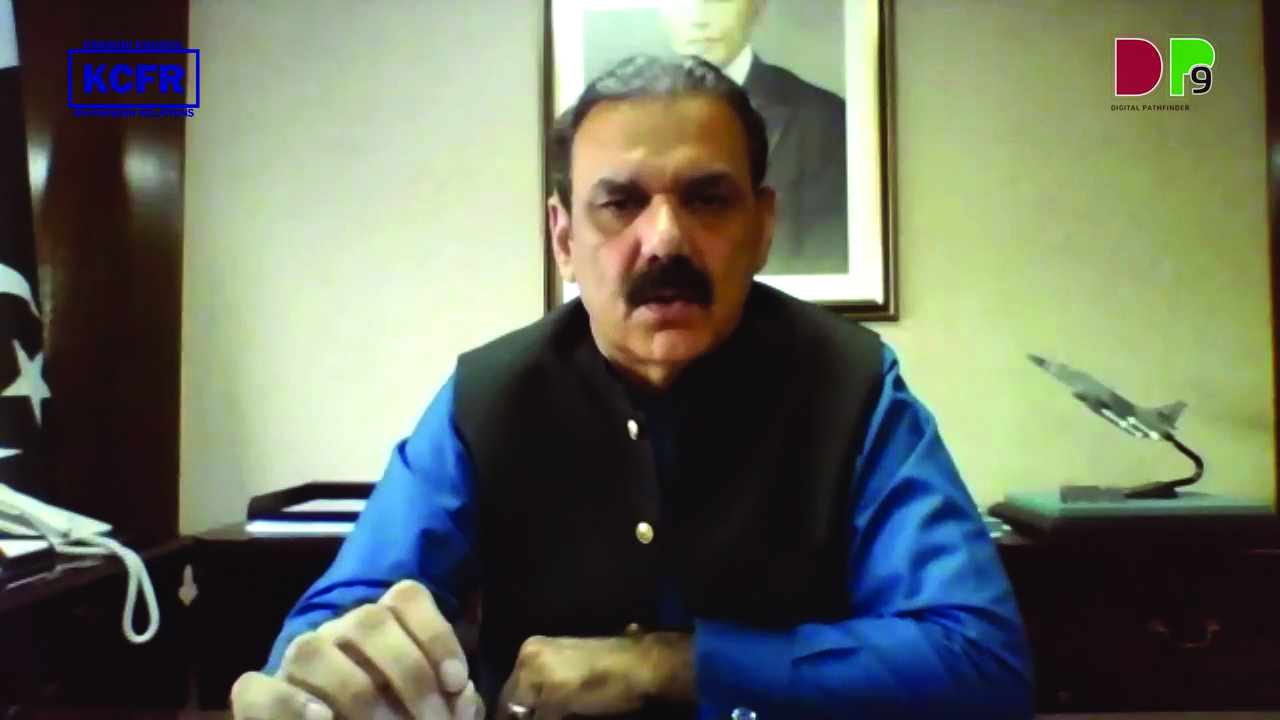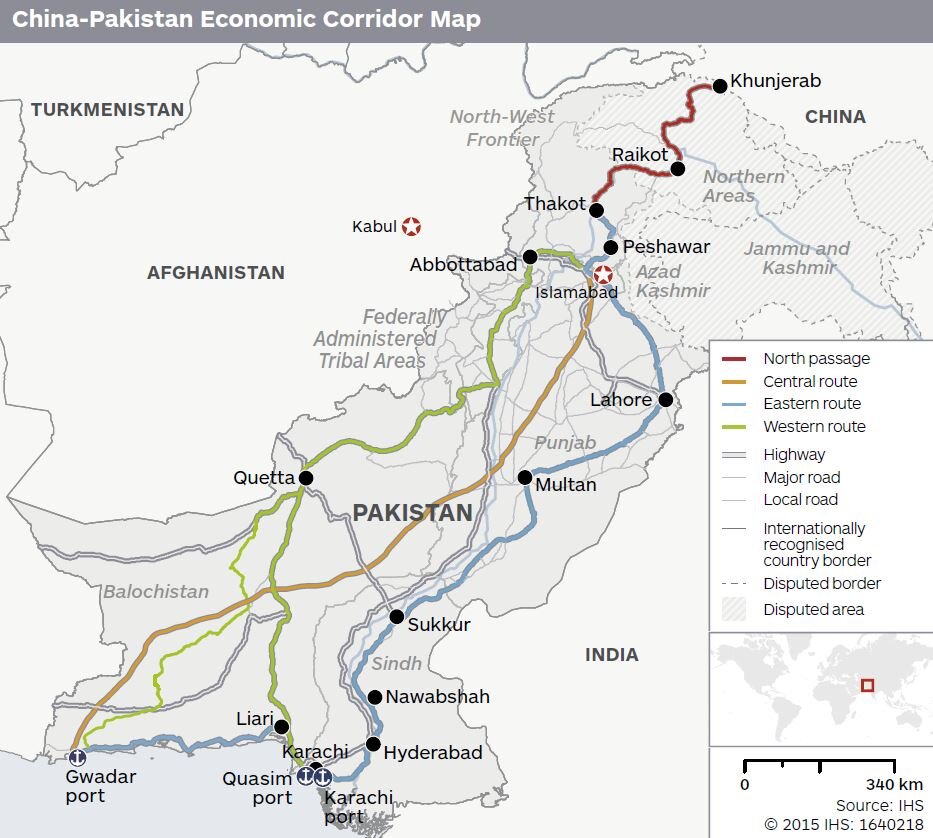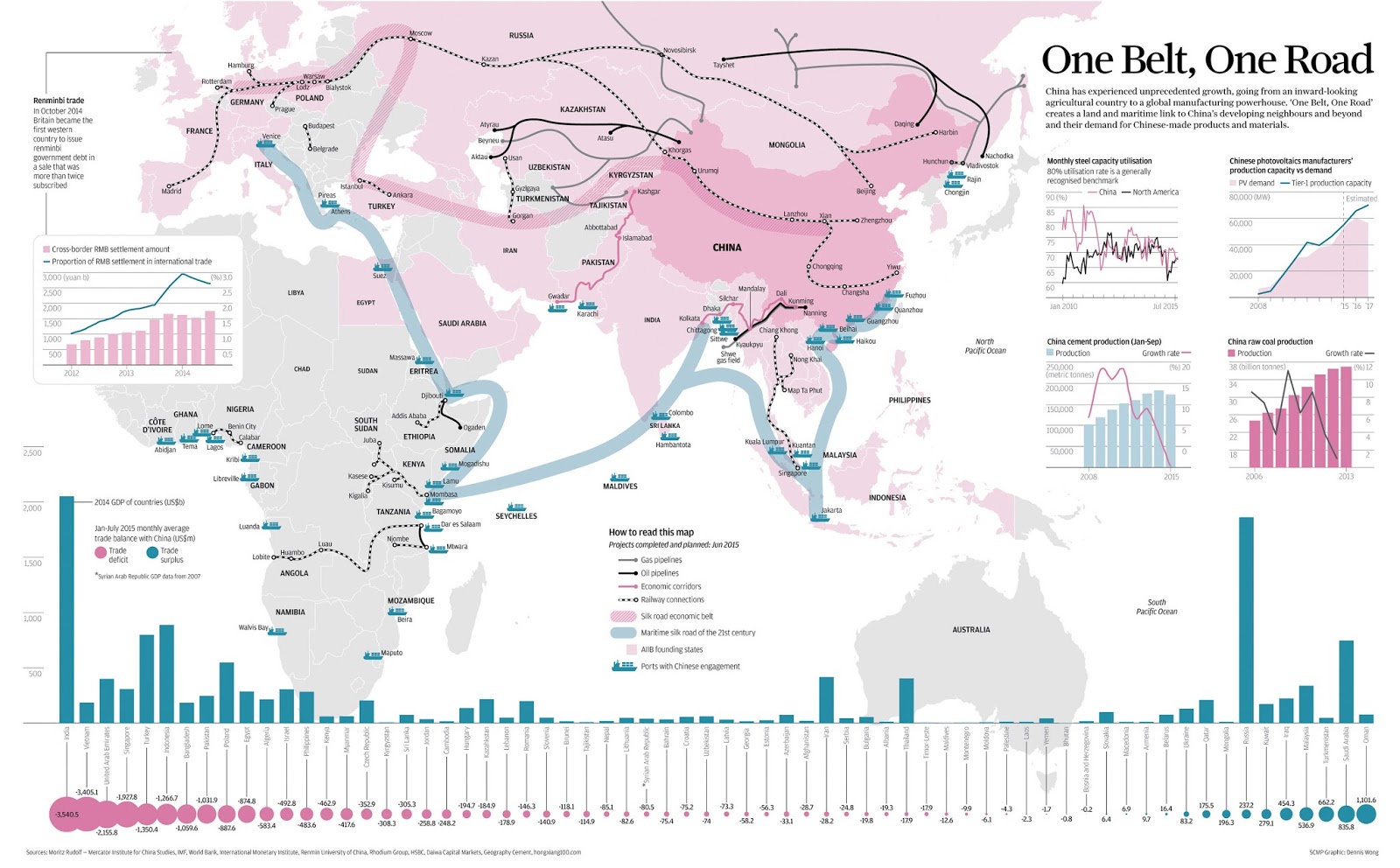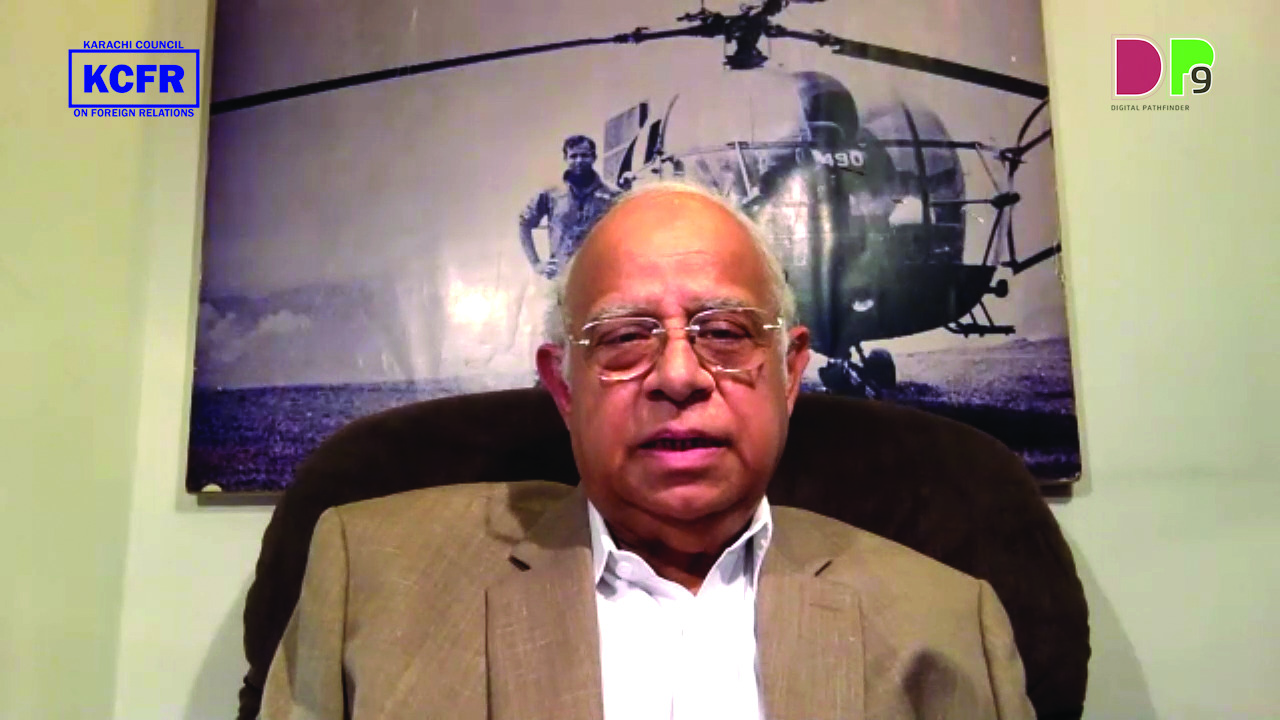A webinar was held on 23rd July, 2020 on “CPEC and its Significance for the Region” under the auspices of Karachi Council on Foreign Relations (KCFR). Chairman KCFR Ikram Sehgal hosted the session. Prominent speakers introduced by the Chairman were, HE President of Pakistan Mr. Arif Alvi, Chinese Ambassador Yao Jing and Lt. Gen (Retd) Asim Saleem Bajwa Chairman CPEC Authority.
Chairman KCFR thanked President Arif Alvi for taking time out of his busy schedule and also thanked the Chinese Ambassador, who upon being called responded without hesitation. Mr. Sehgal said that “we are also lucky to have with us Lt. Gen. Asim Saleem Bajwa, Chairman CPEC Authority, who spent an extensive period of his military career in Gwadar which gives him a unique insight into the CPEC project”.
Invited to initiate the discussions Lt. Gen Asim Bajwa said he was speaking on a subject close to the heart of every Pakistani, saying “CPEC is a transformational project, a game changer which is something I would hear every so often before resuming the charge of CPEC authority. After coming into office, I saw the potential and scope of the work to be done and ground reality impacted by CPEC and it became clear that the phrase ‘game changer’ has been coined with considerable thought [in reference to CPEC]”. He said that the environment in the region was improving by the day and Pakistan is emerging at the centre of this new wave of peace and prosperity which is becoming visible in our own lifetimes. He said that he and Mr. Yao have been speaking and working together quite closely, with our discussions being discussed purely on the advancement of this project.
Recapping he said that Phase 1 of the project was ‘the Early Harvest’, basically meant to fill the gaps in infrastructure, both in communications and energy and identified the three routes being built under the CPEC project connecting all major cities of Pakistan with Sea ports. He said that good headway was made in context of building roads. After the Eastern Route from Peshawar to Karachi, the Multan to Sukkur motorway was recently completed and only one section is left, the Sukkur to Hyderabad one which has been approved and will be tendered soon, hence the Eastern Route will be completed. Lot of work is being done on the Western route, two portions of which have started already while two more are left one pending approval and only one further. The Western routes passes through remote areas will be of great support to the local economy and will help to mobilise all logistics from China to Pakistan in Gwadar and vice versa. He said that Now we are preparing for Phase 2 which is the expansion of work from Phase 1 with four areas being focused on. Number 1 is ‘Mass Industrialisation through Special Economic Zones’. A total of 9 zones are to be built, currently working on 3 of them, one in Raskhai, one in Faisalabad, and one in Dhabeji next to Karachi. Focussing on the agriculture aspect Lt Gen Asim said that there are three points: 1) Enhancing the yield, 2) Induction of technology, and 3) water conservation and farm management. “We are collaborating with the provincial governments and identifying unutilised land, trying to create collaboration with Chinese corporations and link them with the provinces for corporate farming. We are working with the Ministry of Science and Technology to create capacity to build lithium batteries, solar panels, pharmaceuticals and chemicals, etc.”

Lt Gen Asim Bajwa informed participants that CPEC is being taken into the tourism sector which has lot of potential but we are suffering because of lack of system and lack of infrastructure. He said that Chinese companies were being invited for projects such as infrastructure, cellular coverage, power shortage, etc. and tourism zones were being identified build hotels/ restaurants, etc. He said that “we need to prepare before we move into industrialisation. We are picking up clusters of NABTEB and TEVTA run training institutes, working with the Chinese, they have a $1bn fund to upgrade those tech institutes to go from basic manual labour to robotics manufacturing, then the workforce will be able to automatically go and work in those industries”. In Karachi, he said that we are working with Chinese companies to come and work in the port infrastructure. The ports have a lot of potential but they are under utilised because there is a lot of work which has to be done and we don’t have the skilled manpower to do this.
There are other infrastructure projects next to the port under development. CPEC is basically meant for mutual shared benefit for China and Pakistan and we want it to create value for the common people of Pakistan, through industrialisation, agriculture and so on, our own people must benefit. Science and Technology and also Tourism will also uplift our economy and provide employment opportunities for the people of Pakistan.

Chinese Ambassador Yao Jing thanked KCFR for hosting this very significant webinar on CPEC in the wake of COVID 19. He said he will focus on the context formed in the wake of the Coronavirus. He said that just this morning he had I received a call from the honorable President of Pakistan and discussed what stages were next on the project and also in fighting the pandemic. In the wake of COVID 19, there are several changes. The first is that the global economy is under recession and the Chinese government as well as the Prime Minister of Pakistan are both working towards revival of the economy for their respective nations. In the backdrop of COVID 19 and its aftermath, we have had to adapt the CPEC project to shield it from economic adversity through government policy, and looking at the new economic requirements for this project. Several projects, especially in the area of construction have been approved and started, and we are in close collaboration regarding implementation of the mainline railway project. PM Imran Khan made it clear that the construction sector is key for boosting employment and stimulating economic recovery after coronavirus. This is a key part of our mutual collaboration through CPEC, and the concept behind CPEC is mutual benefit. In the social sector, we are going to shift more resources to deal with the immediate challenges regarding the prevention, control and treatment of COVID 19, including more resources for the medical sector. There is another challenge in the form of locusts attacks for which we will establish a pest control laboratory in Karachi, in collaboration with the Ministry of Food Security. This is one of the aspects of CPEC including collaboration with the Pakistan government to build momentum for economic revival and activities. There is also the aspect of mid-to-long term cooperation including industrial, agricultural, tourism, water resource management and science & technology.
Ambassador Yao Jing stressed that all of these were important, and that “we are in close collaboration with various departments and ministries of the Pakistani government to start this, because the fundamentals of an economy are based on manufacturing and production, and we are going to build a business forum to facilitate capacity building in these areas for the Pakistani exporters. As a result we can see good signs of increased FDIs still coming from China to Pakistan in good quantity”. The Ambassador said that CPEC is also faced with certain challenges related to regional and international development issues involving the barriers of protectionism and unilateralism. Despite emphasising that the CPEC is designed as a collaborative platform between regional and neighbouring countries, including central Asia and Afghanistan, the anti-globalisation trends CPEC is falling under suspicion and criticism. The fundamental task for China and Pakistan is to build this platform as a regional and international collaborative platform by maintaining inclusiveness and openness. Although primarily, this platform is designed for Chinese and Pakistani business interests. I appreciate the leadership of Pakistan and the CPEC Authority for their devotion and energy towards building the CPEC, which is evolving from a primarily infrastructural and economic project towards one which has impact on the B2B sector, and from there to social issues towards P2P cooperation. On the Chinese side, we are devoted to this project and want to see it progress in collaboration with our Pakistani counterparts to build it as an example of inclusive, open and beneficial projects for all.
His Excellency Arif Alvi President of Pakistan thanked the Chair for giving him the privilege of addressing the webinar. He pointed out some aspects related to the vision of the Chinese leadership with regards to the BRI project and its impact on the region. Historically, peace and war have been tied down to trade routes and the ability to conduct trade, war always disrupted trade routes. In view of the original Silk Road between China and Pakistan taking place through the Karakoram range, as long as there were trade routes intact there was peace and prosperity through movement of goods between nations, and particularly the purchase of goods from poorer nations by prosperous nations via imports. These are the core factors behind the BRI/CPEC projects initiated by the People’s Republic of China. We have made a lot of progress on CPEC, ultimately it is a $64bn project which will keep on expanding as needs for communication, rail, fibre, road, energy and pipelines as well as other types of trade lead to popularising of these routes and periodically increasing upon the infrastructure to be built. As peace returns to Afghanistan, it is very important that trade takes place through Afghanistan and Pakistan via Gwadar, the Pakistan government has assured that Afghan trade will be initiated through Gwadar and I think as peace progresses the contribution of CPEC in rebuilding Afghanistan will be apparent. In the CPEC about 19 projects have been completed with 28 under implementation and 41 in the pipeline.

Giving examples, he said that in the Multan-Sukkur expressway 392 km has been completed, along with the project in Harcourt. “The ML1 for which I was in Beijing in March to communicate with the Chinese President, involving a rail link between Karachi and Peshawar which is going to be inaugurated soon. The optic cable from Khunjerab to Islamabad has been made, but the Islamabad-Karachi-Gwadar has to be built”. He said that Gwadar is the crown jewel as it links water to the Chinese North Western regions as well as Central Asia. In Gwadar the East Bay express way and the airport links it to the world in different ways. As far as energy is concerned we have a 300 megawatt coal fired plant as well as water desalination which we need as special economic zones and industry grows, we need a 1.2m gallon per day desalination plant. As far as CPEC is concerned initially Pakistan needed energy for which there are 9 operational projects with 5320 megawatts of energy going through them, 3 are under construction. The President congratulated the Pakistan government and the Chinese for the Diamer Bhasha dam which is in process of completion, this has opened 16000 jobs, it is also the biggest storage space after Tarbela dam. Pakistan is looking at conservation of water, and also looking at usage efficiency and storage methods. “We are looking at exports and trade through the CPEC corridor. Trade within Pakistan has increased, tourism has been impacted due to COVID 19, we went into a smart lockdown, and the industrial sector was not overburdened by lockdown and out of work people. Exports have been almost on the line, Pakistan has recovered well, we are impressed by the Chinese governments’ handling of the situation”. President Alvi said that during his visit to China when COVID was at its peak the Chinese were kind enough to guide us and we also had processes in place on the ground via prevention and usage of masks, as a result of which we managed the curve and cases have been going down, this shows good cooperation between Pakistan and China. Delegates of Chinese doctors had come to Pakistan to guide us due to which today we are better at handling the pandemic now.

This project will enhance trade development in Pakistan. He said that Pakistan is looking at poverty eradication, creating special economic zones and tax havens which will provide work opportunities for the masses. The construction sector will play a big role in reducing poverty, we have been focusing on improving health and education and through the same processes, reduction of poverty. There is criticism that this project overburdens our economy, I say that it in fact improves the capacity of the people, and we should be able to pay back our loans, most of which are between private entities. This is not focused on exploitation but on the needs of different countries.
He then went on to highlight the cooperation between China and Pakistan in other areas, particularly those from where Pakistan has learnt from China. He said that he was hopeful as far as the CPEC corridor is concerned will ensure peace in the region. “Communication in every form improves peace, and removes friction. We are facing a belligerent situation in Kashmir, and intrigue in Balochistan discouraging CPEC work, and I am sure we will overcome this. I thank all the participants and the KCFR for highlighting this topic.

Concluding the Webinar, Chairman Ikram Sehgal said that CPEC is not only important for this region, it changes the geopolitical dynamics. For example, he asked ‘why did Japan go to war during WW2?’ It went because resources it was used to having in South East Asia were denied to them by the predominant naval powers which at that time were the US and Britain. After that, fleets became very important, and there were no real land routes available, BRI changed the geopolitical dynamics of the world. Shanghai to Paris by rail takes place in 15 days, whereas by sea it takes 45 days. There can be no interdiction the way it is possible by sea. The great development in Pakistan and the region is the development where Chabahar has been taken over by the Chinese, as well as the energy projects. Technically, today, it has become the China-Iran-Pakistan economic corridor. Let me put in a word for the great work of the Pakistan army. The roads in Balochistan would not have been possible without this, the amount of effort is commendable. The security situation in this region has improved, I thank General Bajwa and his predecessors for this. We must make sure that we don’t exclude others from CPEC, as it is in the interest of parties in the West, the development that takes place affects the whole region. Despite the differences among the Pakistani political parties, all of them in general have contributed positively to the CPEC project, particularly the PTI for establishing the CPEC Authority. Developments in the region can be force multiplied by the communications and transportation possibilities in future. We are passing through very difficult times, most difficult for us that our neighbour, India is behaving in some form as a spoil-sport, trying to disrupt the project, hoping to disrupt and derail the CPEC project. This project is not so easily swayed, it is not a figment of imagination, it is a reality for the progress of the people of Pakistan as the honorable ambassador has mentioned that per capita income will increase as CPEC starts to unfold. We have a power surplus in power, with the dam projects coming up, the hydroelectricity will move up. We recommend the CPEC authority to think about more smaller dams in Balochistan which will open up the potential of unused land through better water resources. I thank the Ambassador for reaching out and accepting the calls without hesitation, agreeing to come on the webinar, and I am sure he will appreciate the usefulness of the CPEC Authority being set up as a one-window solution to help resolve issues related to CPEC progress, there certainly are administrative obstacles to working in this region, but the Chinese are a gentlemanly people who usually will not express this type of sentiment in public. To all the participants I have to say ‘Thank You and God Bless’.
Before the Chair’s concluding remarks, a few questions were taken by the speakers:
Q) When will the Sukkur-Hyderabad road project be completed? [A. Bajwa]
A) It will be tendered soon and I see this work beginning at the end of this year or Jan next year, which is a 3 year project, which will hopefully materialise by mid 2023.
Q) When is the Gwadar Port going to be completed? [A. Bajwa]
A) The Port is now operational as we have ships coming in, as well as consignments for Afghan Transit Trade, and moving through Gwadar into Afghanistan. While the port is operational, work is ongoing for the Gwadar Free Zone, Gwadar International Airport, and the Gwadar coal power project which is a 30 month project. The port however is already complete and operational.
Q) In how many areas are China and Pakistan together, could you name some? [Mr. Yao Jing]
A) As far as the first phase of CPEC is concerned, we have four: Gwadar Port, Infrastructure, Transport and Industrial Cooperation, this is the first phase. After the second stage starts we have another four focus areas; Social Sector [COVID management]; Agriculture, Science & Technology and lastly is the aspect of people-to-people relations. This is actually only a part of the total China-Pakistan cooperation, not including aspects related to defense, private sector, and also multi-laterally [UN/International Orgs]. CPEC is to be diversified once infrastructure is sufficiently developed, at which point more stakeholders will be included. Poverty alleviation is the focus of PM Imran Khan, he has mentioned this is the specific area he wants to focus on. This is a very comprehensive prospect, it involves improving communications at the grass roots level, there needs to be provision for health, education and water management at the ground level. Poverty alleviation is really the end purpose for a variety of collaborations among different sectors. Currently we are following the core government priorities, firstly, to engage the construction industry, then to build more employment, focusing then on the private sector and then on community participation.




